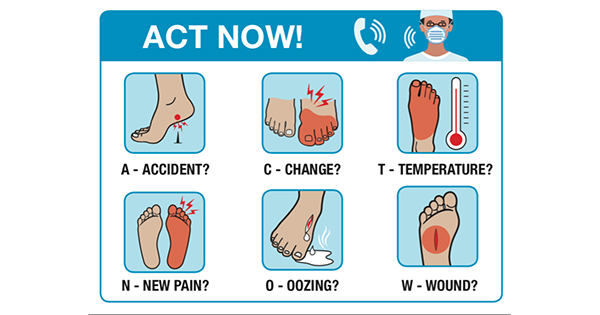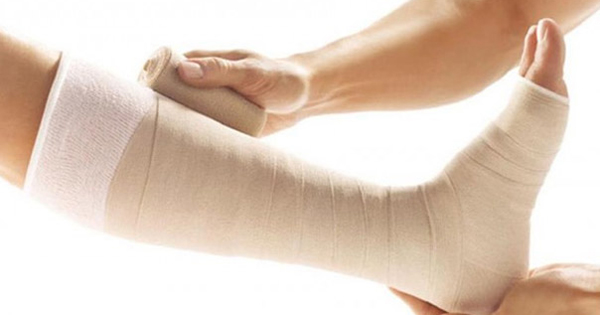Offloading has been described as “arguably the most important of multiple interventions needed to heal a neuropathic plantar foot ulcer in a person with diabetes” (Bus et al, 2019). Since 2019, there has been a focus on effective offloading following a review of the evidence and the subsequent recommendations from the International Working Group for the Diabetic Foot (IWGDF; Bus et al, 2020; Figure 1). Following this, the Scottish Foot Action Group commissioned and compiled a consensus document which addresses the use of offloading in practice.
These documents have provided guidance and clarity around the standards of practice for clinicians to deliver effective patient management and optimum clinical outcomes. They provide an opportunity to review current practice and identify where offloading practices need to improve.
Despite offloading being an essential part of treatment, it has been observed that it is not always implemented, with use as low as 2% in some populations with diabetic foot ulcers (Messenger et al, 2017; Guest et al, 2018).
In response to this, a number of key clinicians were invited to attend one of a series of online discussion groups to identify potential barriers to effective offloading in their practice and share “best practice” in how they were meeting this challenge. Five meetings were held in total. In preparation for the discussions, the delegates were asked to submit a SWOT analysis of offloading within their practice. All of the sessions were sponsored by OPED UK (manufacturer of the VACOcast Diabetic Boot) and 26 people attended.
There was a standard format for the meetings. Each one started with an introduction to the pathology of diabetic foot disease and the subsequent need for effective and timely offloading to prevent and manage the resulting complications of Charcot arthropathy and ulceration. This was followed by a review of evidence to support the implementation of offloading in practice, and a review of the devices available and their efficacy.
Best practice in offloading
The recent recommendations made by the IWGDF were used to identify best practice in offloading (Bus et al, 2019). The use of a knee-high, non-removable device with suitable foot–device interface for offloading for an uncomplicated neuropathic plantar or mid-foot ulceration is often considered the gold standard. This includes the use of non-removable knee-high walkers, as well as total contact casts (TCC). If this is contraindicated or not tolerated, a removable knee-high device with a suitable foot–device interface may be considered. If these interventions are not available or not tolerated by the patient, felt/padding and a so-called ‘offloading shoe’ are also available (Bus et al, 2019).
TCC is an umbrella term that encompasses all types of casting for pressure relief. For the purpose of the discussion groups, it was agreed that this should encompass all knee-high unremovable devices used for offloading.
Although all national and international recommendations are clear on the use of non-removable, knee-high walkers and TCC as routine for first-line offloading, this is not mirrored in practice. In many cases, felt/padding and offloading shoes are used as routine methods, which is contradictory to the evidence-based recommendations.
Barriers to offloading
Throughout the discussions, a number of factors were identified that influenced the provision of effective offloading. The clinicians contributing to the discussion groups were from a range of professions, including podiatry and orthotics from hospital and community care across the UK, providing a wide range of experience. The barriers to offloading were discussed and encompassed the service structure, the ability of the clinician, the availability of effective devices and patient adherence.
Service structure
Effective care is best delivered in an environment where a service is well structured, with good communication internally and with other clinicians involved, across both hospital and community care. Within this, it is important that up-to-date clinical frameworks and guidelines are in place, which are regularly reviewed, and there is a formulary for products and devices required.
A multidisciplinary team approach was considered to be an important factor in providing effective care, with good interdisciplinary collaboration from a range of professionals and joint professional reviews. This not only supported best practice, but also delivered consistent patient information and contributed to shared learning. One example was working with the tissue viability nurse to identify at-risk patients with diabetes and a heel pressure ulcers, providing joint skills and knowledge.
A cohesive service between acute care and community foot clinics was also considered to be essential for a more consistent level of care that could be escalated when necessary and followed up effectively. Effective communication between the different professionals needed to be supported for accurate and detailed record keeping, so it is necessary to use electronic patient records and to have access to cameras to document patient progress.
Poor collaboration and communication between services was identified as a factor that contributed to ineffective offloading. When shared pathways or formularies were not used, patients often received inappropriate devices. This is particularly relevant in the community because of a lack of awareness of staff, lack of availability of devices, or GPs who may not prescribe recommended treatment.
Availability of budget for offloading
Although offloading is an essential part of a podiatry or foot health service, the budgets are often held in other departments, such as orthotics or the plaster room. As a consequence, offloading is often not performed at the point of care and the podiatrist has limited influence over the choice of the offloading method. This can lead to a disconnect between diagnosis and management, and adds in extra layers of bureaucracy.
When funding for offloading is available to the podiatry department, clinicians are more likely to apply the appropriate offloading at the point of care.
While offloading is essential, the budget for it may be insufficient, as offloading may be competing with other elements of care, such as wound care products. This adds to the misnomer that the primary treatment for wounds is a dressing, when, in reality, it is the other interventions such as offloading or compression, which are crucial because they addresses the underlying cause of the ulcer.
Traditionally, the more complex methods of offloading, such as the TCC, were applied in secondary care settings. This has changed in recent years, with many proactive primary care services recognising the need to implement this treatment within their clinics at the point of initial care. They support this with funding applications and formulary listings to allow them to follow evidence-based practice.
However, in many community settings, there is still no or only a marginal budget, which means offloading is often not optimised. Prescription of offloading devices is often dependent on GPs’ understanding and willingness to follow the podiatrists’ recommendations. As a result, clinicians are unable to follow the recommended guidelines which promote evidence-based practice and have to resort to using low-cost and less effective first-line treatments, such as felt/padding or inexpensive offloading shoes. Consequently, wounds fail to heal, become more complex and the treatment period is prolonged, increasing the cost of care, the burden on healthcare and distress for the patient.
Clinician ability
The delegates identified that a well-trained and skilled podiatrist made an important contribution to management of the diabetic foot, and in implementing offloading in the plan of care. This worked best when staff were dedicated, motivated and open to innovation and had opportunities for personal and professional development at all levels of clinical experience. Although there is often a team of clinicians who support the management of diabetic patients with foot complications, podiatrists are the key clinicians and they most frequently assess, implement and direct care.
It is relevant that the podiatrist can take ownership of both patients and service provision within diabetic foot care. The extended role of non-medical prescribing was highlighted as a positive factor in supporting effective offloading, in that prompt and effective offloading devices can be prescribed and fitted as needed.
Best practice in podiatry was demonstrated in an environment where specialist and non-specialist staff regard training and upskilling as beneficial and willingly participate. Examples of training opportunities included:
- Putting staff rotation systems in place to share learning with other professions and increase competence and confidence, especially in using offloading devices. This ensures that staff were aware of the range of devices and could use the most appropriate device for the patient’s need.
- Providing career opportunities and supporting clinicians to develop into new roles
- Encouraging podiatrists to achieve independent prescribing status and to actively use this opportunity to access evidence-based treatment
- Making the best use of skilled podiatry time by using podiatry assistants for some tasks, such as casting
- Using frameworks and pathways to support clinical competence for staff
- Considering using the training opportunities offered by the commercial sector.
In contrast, the delivery of effective care was hindered in environments where clinicians had limited opportunity to increase their knowledge base because of poor or inconsistent staff education, and lack of clinical leadership in offloading. This impacted on their awareness of offloading methods and confidence in their ability to implement effective treatment.
Offloading was identified as the most time-consuming part of the management of the diabetic foot, and when this was restricted — either by lack of staff or overbooked clinics — this essential element of care was often limited or overlooked.
If offloading is ineffective, ulcers may not heal or may deteriorate. As a result, the treatment period can be prolonged with additional appointments required, which puts pressure on already overloaded services and clinicians working under massive time constraints.
Availability of clinically effective devices
The ability to offload the foot effectively was increased when podiatrists had access to a range of clinically effective materials and devices that they were skilled and confident in applying at the point of care. This was considered important not only because the podiatrist maintained clinical competence and ownership of care, but also it was better for the patient, who was managed within one appointment and at one location.
However, there were a number of reasons why clinically effective devices were not available:
- Devices were stored in a central location, which led to delays in accessing the relevant equipment
- Lack of storage space restricted the range or size of devices
- There were no funding pathways in place and budgets were limited or not allocated. In some services, the budget was held by other departments that also provided offloading, such as the plaster room, which often reduced the podiatrists’ autonomy to make informed choices
- The formulary does not have a section specifically for “offloading”. If this was in place it was not regularly updated to reflect current practice, or the choice of device was based on cost rather than clinical effectiveness
- Inadequate budgets and out-of-date formularies often predisposed to delays in procurement
- There is also limited choice on the Drug Tariff. There is a lack of awareness of availability and how to access this information. There is confusion with clinicians on differences between accessing products in acute care compared with prescribing products in primary care, and this leads to confusion in budgets and who is responsible for budgets.
The majority of podiatrists within the discussion groups had access to TCC devices (non-removable knee-high walkers and traditional total contact casting). Some of the individuals identified that they had the skills within their departments to apply the traditional casting methods. While these were reported to be effective, they were time-consuming to apply and remove within the clinic environment and required sufficient clinicians with the training and competence, which included covering for sickness and holidays. Maintaining these skills was also a consideration and time to do this was a limiting factor within existing services.
A number of the delegates had used devices as both removable and non-removable within their clinics because these devices are easy and quick to apply. They had observed good wound progression and anecdotally patients experienced less skin rubbing than with traditional total contact casting and other TCC devices. They could educate the patient to use them effectively, supported by the educational information provided by the company.
Patient adherence
The reluctance of patients to comply with offloading of the foot was considered a major issue in implementing effective care. The device used should not only provide sufficient pressure relief, but also be suitable for the patient’s health state and lifestyle. While a non-removable TCC is indicated for clinical reasons, this may not be compatible with the patient’s frailty, limited mobility, mental capacity or employment requirements, such as having to drive.
While some patients were reported to refuse offloading, others would not consistently use equipment once applied or fail to attend appointments for review. When non-removable TCCs were used, there were numerous reports of patients removing them for different reasons, including discomfort and lifestyle limitations, not understanding that the inconvenience can outweigh the benefits.
The success of implementing effective offloading was considered to be a skill that podiatrists needed. The importance of communicating with patients to get them to understand the importance of offloading and that it was part of their treatment was identified as essential to promote adherence. Strategies included providing training and education and positive reinforcement at every opportunity.
The clinicians who applied the devices needed to be positive and demonstrate confidence to the patient. One negative behaviour was using offloading as a threat to the patient, rather than a positive addition to their treatment, e.g. saying to the patient they will need offloading if the wound does not improve. Another is applying offloading only after several weeks if treatment is failing.
It is also important that professionals from all disciplines involved in care collaborated to avoid confusing the patient, as this would often promote non-adherence. Anecdotally, patients who were offloaded at the start of their care and understood the need for the device achieved better clinical outcomes.
Discussion
The value of discussion groups among clinicians enables them to share best practice and contribute to clinical and professional development. The information generated through this project indicated that the provision of offloading for patients with diabetes and foot complications varies widely across the UK. There were examples of excellence where podiatrists were providing evidence-based practice at the point of care and using gold standard offloading as recommended in the guidelines. However, in other areas, clinicians were experiencing one or more of the challenges identified, which prevented implementation of the IWGDF recommendations, and subsequently compromised patient care.
It was decided that podiatrists can influence the standard of care in offloading by being proactive and demonstrating their knowledge, skills and expertise in this area through a checklist of actions. They should:
- Use key documents, such as the IWGDF guidelines, to highlight to key decision makers, such as clinical leads, procurement and budget holders, where evidence-based practice recommendations are not being met because of access to effective offloading devices (Bus et al, 2020)
- Budget for efficient offloading should be held in the podiatry department to allow effective, evidence-based offloading at the point of care. Be specific about what equipment is required, supporting this with clinical evidence
- Implementing common communication ways and close collaboration between the multidisciplinary team in hospital and the community have been shown to improve the level of care for the patient
- While the traditional TCC is widely recognised as best practice, the barriers to implementation are huge (time consuming, not available everywhere, skills, safety). As a consequence, effective offloading is widely not applied. There are modern technologies available that are suitable as first-line offloading methods because they are safe, easy and fast to apply, and have shown the same efficacy as traditional total contact casting. The devices can be made available by the company at the point of care
- Increase and maintain skills and confidence in offloading by investigating the opportunities offered through staff rotation, alternative placement schemes and joint training opportunities. Also consider the contribution that education programmes offered by commercial companies can provide
- Lead the patients though their journey. Engage with the patient at every opportunity to educate them and support them in managing their offloading devices.
Conclusion
Effective offloading is an essential and non-negotiable part of the management of the patients with diabetes and foot ulcers. It is a skill that is part of clinical practice within podiatry and supported by national and international guidelines.
The COVID-19 pandemic has caused major disruption to existing services and had an impact on patient care. Access to hospital services has been reduced, which has affected multidisciplinary team clinics and access to plaster room for application and removal of offloading systems.
In response, community podiatry services have had to make several changes. These include virtual consultations, the frontline of the multidisciplinary team moving towards the community and podiatrists having to step up in clinical decision-making to meet this challenge. It is important that access to effective offloading is not compromised, and that the expertise and budget for this essential part of diabetic foot management is available in primary care.
The opportunity provided by the discussion groups enabled clinicians to identify key barriers to effective offloading and exchange best practice with their colleagues. This was considered a valuable exercise in supporting them through a period of unprecedented challenges to clinical practice and provided them with new ideas or support to make changes to improve patient care.





